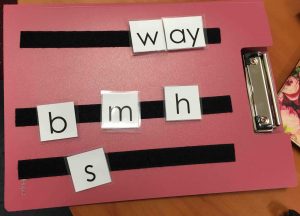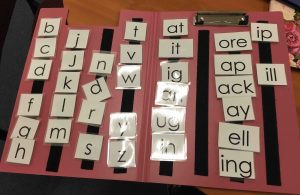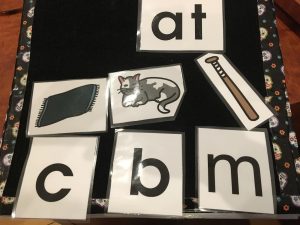Phonemic awareness is an important skill – it is what we use to hear sounds in speech. Without phonemic awareness, we cannot break words down and decode them to read unfamiliar words. We also find it extremely hard to re-code words to spell them. Therefore, phonemic awareness is a very important skill in learning to read and write.
In my previous couple of posts about word walls, I talked about the onset rime word families as a tool for teaching decoding and re-coding, which are conventional literacy tasks. Onset rime can also be used with emergent students to help them hear the sounds in speech, also known as phonemic awareness. Hearing these sounds is an important skill for learning about letters and the sounds they make in words and this can develop when students are emergent – and continues to develop once they are conventional.
Onset Rime has been shown to be one of the most effective ways of improving phonemic awareness and doing some short onset rime activities regularly with emergent literacy learners can help them to start to hear sounds in speech – which, in turn, helps them to learn to work with words later in their literacy development.
Below is a plan for working on onset rime across a week. This is intended as an example – you can continue with similar and different activities with other word families to help each literacy learner develop this skill. It is important to remember that these activities are not done with the aim of a student getting each word family “correct” or the with aim of them learning to spell the word family. The aim here is for literacy learners to increase their ability to hear sounds in words – and this might happen over several weeks or months of repeating onset rime and other activities.
Generally, I don’t start these activities until a student knows at least 50% of the alphabet. There’s no research basis for this – just my experience is that this is when the student begins to know enough about literacy that this makes sense.
In the onset rime plan you’ll notice that for the first three days of the week, the tasks are passive or exposure tasks. We introduce the word family and interact with it. The tasks in the first three days are ones that don’t have any “right or wrong”. Then on Thursday and Friday we start introducing tasks that need the student to start listening and discriminating. This program should take you less than 10 minutes each day.
Overall Resources


I find it really helpful to have onset rime folders that I can pull out and use – and that are designed so I can use them as quickly and easily as possible. The photos above show how I make them up – common onsets are on the left-hand side; rimes are on the right-hand side. The front cover of the clipboard has Velcro strips where I can put just the pieces I need for the activity we are doing.
I have deliberately made the folders up with the rime as one chunk – so that students can easily see that it is just the onset sound/letter that is changing.
I have three different folders for this purpose, each containing a different set of word families. You can download the files to make these up here:
Week Long Plan – Onset rime with the “-at” word family
Monday: Introduce the “at” word family with this song (or any other!):
Listen once through the song, then play it again, using the onset rime folder to make the words as they are mentioned (see the video under Tuesday for an example). Have the rime “at” and the onsets needed ready to go on the front cover of the folder to make the words up.
Offer students the onset letters and when they choose a letter put it with the rime and tell them what word they’ve made. Say the word in a sentence. Remember: this is a passive task. You are just showing the students how changing the initial sound changes the word. Exposure is the important goal at this stage – we aren’t asking students to discriminate yet.
Tuesday: Read “The Cat who just wanted a pat” by Emma Goldston. You can download this from Tar Heel Reader by right clicking the link.
As you read the book, use the word family folder or a carpet board to make each of the words in the -at word family that have a single letter onset. You can reinforce what students are seeing in the book. See the video below for an example.
Hide onset letters around the room and ask the students to find them. As they find them, put the letter they have found together with the rime and talk about the word it makes. Put the word into a sentence.
Wednesday: Read “The “at” word family” by Dawn Alexander

Make up the –at word family onset rime kit created by the clever Emma Goldston from Claremont State Special School and pictured below. Ask students to select a picture and then you make up the word that goes with the picture.
Download files for this activity by clicking here.
Thursday: Read “One Cat” by Jane Farrall. You can read it on Tar Heel Reader or download it.
Talk about the words in the book and ask students to choose which letter they would put in front of “at” to make one of the words. For some students you might offer them a choice of two letters and for others you might offer a choice of more.
See the video below for an example.
Friday Read The Cat by Jane Farrall (again, you can access this or download it from Tar Heel Reader by clicking on the link).
Use the “at” Onset Rime kit to play with the word family in different ways.
For example, you could put a picture at the top and ask the student to select the letter to add to “at” to make the picture.

If appropriate, you could select a letter and put it next to “at” to make a word. You could then ask the student to select the picture for that word. (You will probably need to read the word out to most students.)
Other resources you could use through the week
- Starfall at word activity
- Another book on Tar Heel Reader “Things that end with at”
- Word family sliders: https://www.pinterest.com/pin/19492210857052454/
- Use a large dice to randomly select letters to put in front of “at” (make sure they all make real words)
- Use a spinner to randomly select letters to put in front of “at”. (If you are working with switch users don’t forget the fabulous All Turn It Spinner)
- Word wall HD app which offers some lovely passive tasks in the “writing words” section
- Abilipad app which has some great pre-made onset rime activities in the Abilipad Library
- Anything else you find on Google or your imagination can develop 🙂
And make sure your classroom has a good selection of rhyming books. My personal favourites are books by Aaron Blabey because of their humour and rhythm and rhyme – but of course there is a diverse selection of rhyming books from traditional nursery rhymes to Dr Seuss. There are also some early readers that your school might own which have a focus on onset rime.
Working further on onset rime
There are 37 word families in English so you can bring in a new word family each week to ensure you get repetition with variety. You then do similar tasks to improve student phonemic awareness with each word family. As I said at the beginning – this isn’t about a student achieving any level of skill with one word family – it’s about them developing their phonemic awareness overall. So – change word families weekly, until the student is reliably hearing and finding the initial sounds in words.
Word families: ack, ap, est, ing, ot, ail, ash, ice, ink, uck, ain, at, ick, ip, ug, ake, ate, ide, it, ump, ale, aw, ight, ock, unk, ame, ay, ill, oke, ank, an, eat, in, op, ell, ine, ore.
And a big thanks to Lidia from Adelaide North Special School and Rowan and students from Acacia Hill School for allowing me to share these videos. Also thank-you, thank-you, thank-you to Emma Goldston for allowing me to share her onset rime resources.


Judy valentine
Pam
Pam
jane
Helen Brunner
jane
Amanda Martin
jane